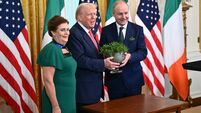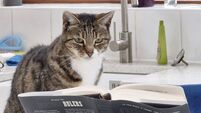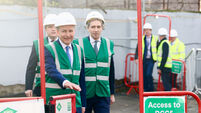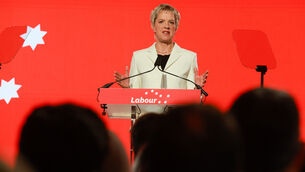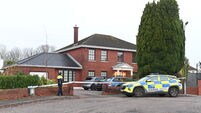Paul Hosford: Paddy’s Day trips have more value than their price tags

Taoiseach Leo Varadkar with Hillary Clinton at the ‘Women at the Helm’ conference in Washington, DC, during his visit to the US for St Patrick’s Day. Approximately €250,000 has been spent on ministerial trips abroad this St Patrick’s Day. Pictures: Niall Carson/PA Wire
Is it worth it?
The question that abounds this week every year as ministers, their advisers, and civil servants leave our shores for St Patrick’s Day trips abroad.
It is a question worth asking of every penny which leaves the public purse and definitely one worth asking of the €250,000 or so (based on previous amounts) which will be forked out this year.
In truth, it may be a question that I am ill-advised to weigh in on, given that I am writing this from a hotel room in Washington DC (paid for by my employer, not the Government to ease some confusion), having spent the evening at a reception at the palatial ambassador’s residence here in the US capital.
But it is at these events in this whirlwind week that you can really see the benefits of St Patrick’s Day as a global celebration.
Here, members of trade groups and lobby groups who have moved into the slipstream of the Taoiseach’s visit, and commanded the attention of government and business bodies on this side of the Atlantic.
One trade lobbyist told me how this week enabled their industry to meet with high-ranking US officials on an issue that could land them millions in exports.

Another mentioned that meeting with the largest US chambers of commerce, unions, and trade bodies is made much easier when the local pubs are festooned with shamrock.
The truth about this St Patrick’s tradition, specifically in Washington DC, is that it is not that old. Ireland began sending shamrocks to the White House in the 1950s, but it was Ronald Reagan who first invited taoisigh.
And it was not until Albert Reynolds was Taoiseach that it became a matter of course for the two leaders of the countries to hold a bilateral meeting when the crystal bowl was handed over.
But in that time, the tradition has grown exponentially and now occupies an entire week. Here in Washington DC, the Taoiseach’s schedule was packed with meetings with IDA and Enterprise Ireland clients as well as with diaspora organisations and local media.
But it also included the Ireland Funds Dinner, a massive gala for around 800 people that helps raise money for the funds, which have disbursed around $600m throughout the island of Ireland.
At that event, the Taoiseach sat with leaders of the US House and Senate, each from one of the two major parties in America, while senators and congressmen were so prevalent that they have their own check-in area.
But also represented were the leaders of the five main parties in the North, sat at one table and being implored by the new US envoy to the country, Joe Kennedy III, to get the institutions of the Good Friday Agreement back up and running.
It was an important visual at a time when peace in the North is both in focus and delicate.
Even more striking was Mr Kennedy, whose grandfather Robert was shot dead, leading the audience in a standing ovation for PSNI Detective Inspector John Caldwell and Chief Constable Simon Byrne and “all those that are fighting for peace and stability and a future we can share”.

The Democrat Senate Majority Leader, Chuck Schumer, spoke of the importance of Irish communities in his native area, “the 33rd county” of Brooklyn, New York.
His House of Representatives counterpart, the Republican speaker Kevin McCarthy, also extolled the virtues and qualities of the Irish, saying that the 14-vote journey he took to be elected speaker was nothing because this great grandson of Cork had the fortitude built into him genetically to keep going. He added that there are no two cultures more intertwined than Ireland and the US.
But maybe that’s part of our issue with the visits? Americans — and Irish Americans in particular — can be earnest and fervent in a way Irish people often struggle with. The kind of West Wing-esque optimism and fidelity to rule-of-decency norms is easy to be cynical about and to make fun of.
And, in the room where it happens, that temptation is no less there, I won’t lie. But while there are some cynics who deploy the Irish-American links, they are in the minority. And the vast majority are people who are genuinely connected to their ancestral home, and who love its people and culture.
And that is something of which we should be proud. A tiny island nation in the Atlantic turns the world green for a week a year and sparks millions of people showing pride that their forefathers had been from our island.
And that uniqueness is what sets this week apart. There is one country leader effectively guaranteed facetime with the US President — no matter who they are — every single year.
There is one country leader who is guaranteed facetime with the US Vice President every year, as well as with Senate and House leaders, senators and congressmen, CEOs, and entrepreneurs.
And this soft power is being replicated at different levels across the globe as ministers rock up to pin a shamrock on just about every country in the world.
I understand the arguments against the enterprise. Nobody wants to think that elected officials are indulging or living it up on the public dime. Our recession-scarred muscle memory tells us that these kinds of frivolities should be done without. And there is an argument that the cost in both monetary and environmental terms is too high for some to stomach.
Others simply want their elected representatives to stay home and work on solving the problems we face. There is also the question of how proudly we can sell a country where nearly 12,000 people don’t have a home.
That question — Can we be proud to be Irish when the Irish State should be better? — is a complex one and one without an easy answer.

But if we are to have a real discussion on the flight of the ministers, we should not ignore the benefits that come with it. And these go beyond just having a politician hand over a piece of crystal to another politician.
Having Leo Varadkar in Washington DC this week enabled countless Irish businesses to make important contacts, meet with US regulators, and network in one of our most important foreign markets, and also in a country in which our companies employ tens of thousands of people.
So, on balance, is it worth it? That really depends on what it is. Is it worth a quarter of a million euro from a national budget of over €90bn to ensure that Ireland can carry out much of its trade missions in one go under the guise of an internationally enjoyed holiday? I would argue it is.
But beyond that, I would argue that Irish people should be proud that these trips occur at all, that there is a demand for them, and that our diaspora has contributed so positively to the world.
You don’t have to pull on the green jersey and ignore the negatives to be proud of much of what we have achieved and who we are as a people, the two things can coexist.
Is it worth it? Probably, yes.





